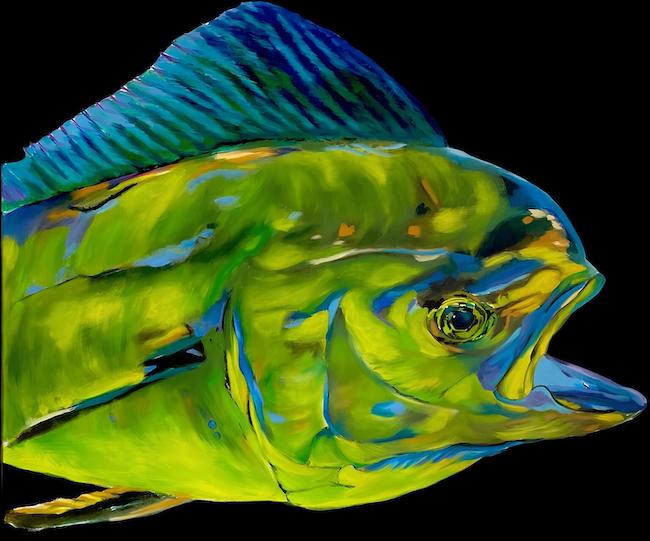Molto spesso tutto ciò che appartiene alla realtà presenta un inedito significato, qualcosa di più nascosto che viene svelato solo dopo uno sguardo più attento, più profondo nei confronti di quelle energie sottili invisibili eppure esistenti, in grado persino di attribuire un senso completamente differente rispetto a ciò che appare a una prima e veloce osservazione. Alcuni artisti tendono a scegliere un solo stile, un linguaggio che consenta loro di muoversi all’interno di un terreno conosciuto in cui si identificano, mentre altri avvertono il bisogno di muoversi trasversalmente esplorando più opzioni espressive per dare sfogo a una poliedricità di pensiero e di rappresentazione necessaria a manifestare il loro approccio alla vita e a tutto ciò che ne fa parte. La protagonista di oggi appartiene a quest’ultima categoria di creativi e sviluppa la sua produzione attraverso diversi temi e anche plasmando i differenti stili di cui si avvale sulla base di un punto di vista inedito e profondo verso soggetti che diversamente rimarrebbero nell’ombra della quotidianità.
Il Ventesimo secolo ha costituito un completo giro di boa nel corso della storia dell’arte andando a scardinare tutte le regole precedenti ma soprattutto introducendo una libertà espressiva che ha reso possibile la nascita di movimenti spesso persino in opposizione l’uno nei confronti dell’altro, eppure tutti in grado di convivere ampliando il concetto di arte come tradizionalmente inteso. Oltrepassato il primo ventennio del secolo dove ogni corrente era ben separata dalle altre e manteneva rigide regole che a volte lasciavano poco spazio interpretativo agli artisti aderenti, successivamente ciò che emerse in maniera via via più concreta fu l’attitudine dei creativi di coniugare le linee guida secondo il proprio sentire, il personale approccio, e di mescolare stili diversi dando vita a qualcosa di nuovo. Questo accadde all’Astrattismo che, recuperando la soggettività dell’autore e il legame con l’emozione si evolse in Espressionismo Astratto, così come per il Realismo che in alcuni casi mutò verso una ricerca della perfetta aderenza alla realtà al punto di essere quasi fotografico divenendo così Iperrealismo; ma anche in quel caso il limite era troppo ingabbiante e così alcuni appartenenti al movimento cominciarono a focalizzarsi su specifici dettagli al punto di farli diventare protagonisti assoluti delle tele, tendendo così verso una nuova Metafisica dove il particolare era spunto di riflessione sulla vita e sulle abitudini di quegli anni Cinquanta in cui il movimento nacque. Il ritratto invece, inteso in senso tradizionale, sembrava non avere più un senso in un’epoca durante la quale si stavano affermando i nuovi mezzi di riproduzione delle immagini, dunque la fotografia e la televisione ma anche il cinema, perciò fu necessario coniugare la ricerca di un nuovo modo per far tornare il ritratto al centro della scena artistica alla privazione dell’accezione elitaria che aveva in precedenza trasformandolo pertanto in un modo di rendere omaggio alle nuove icone che entravano quotidianamente nell’immaginario della nuova borghesia emergente. La Pop Art, questo il nome di un movimento partito dal genio creativo di Andy Warhol ma poi ampliatosi a varie interpretazioni di altri artisti che scelsero il mondo del fumetto, come Roy Liechtenstein e Steve Kaufman, oppure che rappresentarono i condizionamenti della società americana e inglese, come James Rosenquist e Richard Hamilton, innovò il ritratto avvicinandosi ai gusti e alle abitudini moderni. L’artista triestina Giulia Crimaldi sembra assorbire queste esperienze pittoriche del Novecento, l’Iperrealismo, la Metafisica e la Pop Art, per mostrare il suo punto di vista sensibile e profondo nei confronti di ciò che colpisce la sua attenzione, mettendone in evidenza dettagli e aspetti che diventano veri e propri protagonisti delle sue tele.
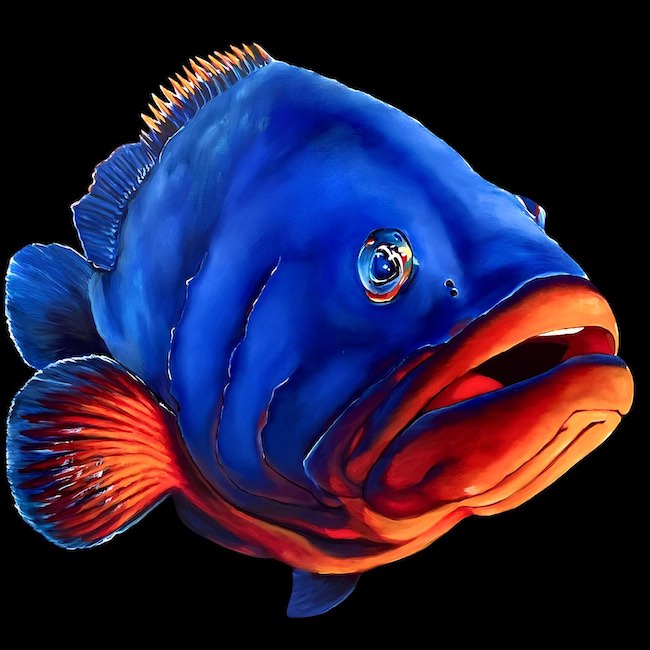
Per quanto riguarda invece la sua produzione Pop Art fa suo il pensiero di Warhol secondo cui chiunque ha diritto ad avere i suoi cinque minuti di celebrità e la applica ai ritratti dei quali sono protagonisti persone comuni o i committenti che desiderino farsi immortalare con uno stile divertente e colorato, quasi irriverente proprio perché gioca con l’autoironia di sentirsi divi, se non nella vita, almeno per il tempo della posa per un’opera che poi rimarrà a ricordare quel momento di gioco.
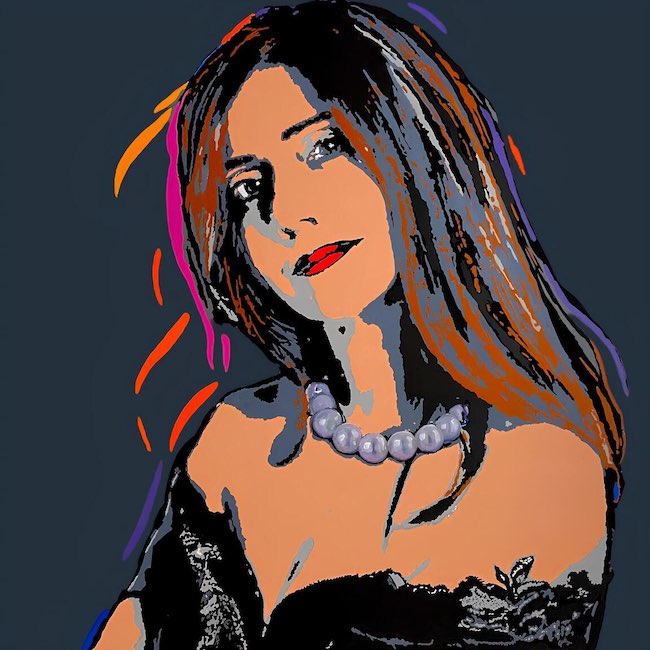
La poliedricità espressiva della Crimaldi non può però essere trattenuta all’interno di un solo linguaggio pittorico e dunque la necessità di adattare lo stile al tema che sceglie di rendere protagonista diventa prioritaria rispetto a tutto il resto, come se la sua identità si frammentasse in tante sfaccettature ognuna delle quali ha il bisogno di emergere e di concretizzarsi sulla tela.
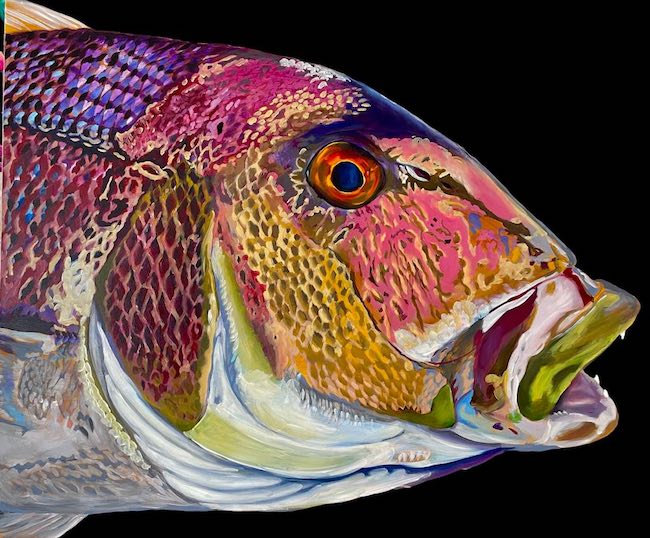
Laddove nei ritratti Pop colpisce la sua tendenza a utilizzare il colore in maniera piena e piatta, avvalendosi nei contorni di linee nette e ben definite e con accostamenti cromatici multipli lasciando le ombreggiature a una cifra pittorica quasi fumettistica, nella serie dei FishKiss emerge invece il suo talento iperrealista che mostra anche un’attitudine Metafisica proprio in quel voler attribuire ai pesci una caratteristica umana, una spiccata e definita personalità riconducibile, per assonanza visiva, a persone reali che sono passate nella vita di Giulia Crimaldi o che incontra quotidianamente quasi per caso. I pesci sono osservati attraverso una lente di ingrandimento, invadono e riempiono l’intera opera mentre gli sfondi sono sempre neri, sia per riprodurre il buio degli abissi marini sia per evidenziare ancor più le tonalità vivaci e variegate della specie a cui appartengono; le espressioni sono emblematiche del personaggio reale a cui l’artista li accosta, ma anche tipiche della tipologia morfologica di ciascun pesce, celando in qualche modo un approccio ironico e al contempo volto a stimolare e a incuriosire l’osservatore.
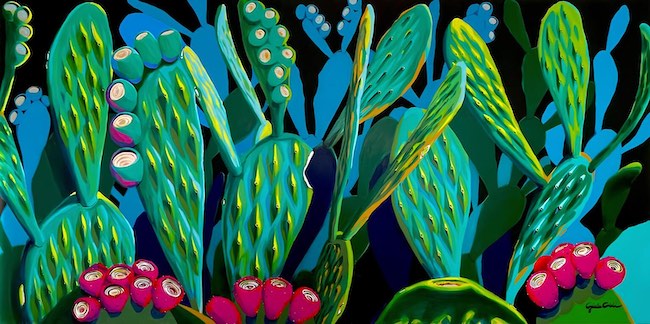
Per quanto riguarda la serie dei Fichi d’India invece, il tratto pittorico di Giulia Crimaldi si avvicina più verso la morbidezza del Realismo, la definizione tende a essere meno precisa, quasi come se nel riprodurre le piante tipiche del sud Italia ripercorresse l’atmosfera vissuta, la memoria di momenti piacevoli e spensierati durante i quali la sua attenzione visiva è stata catturata dalle spinose piante grasse in grado di generare succosi e saporiti frutti. Pur scegliendo i medesimi fondi neri della serie dei Fishkiss, in questo caso le varie sfumature di verde, arricchite dalle tonalità rosacee della fioritura che poi darà origine ai frutti, invadono letteralmente la tela persino con le loro ombre, che si intravedono subito dopo le immagini in primo piano, infondendo una sensazione immersiva nei confronti di un ambiente lontano eppure incredibilmente rilassante che diviene così un perfetto complemento di arredo.
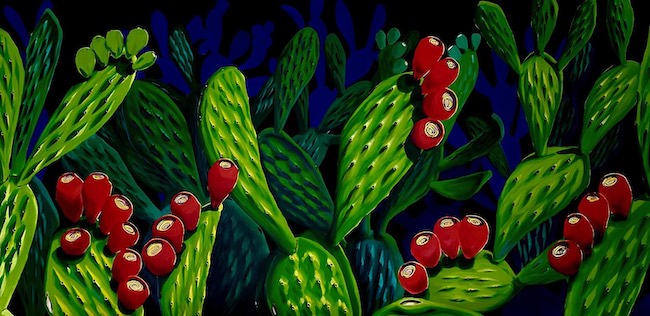
Altra caratteristica di Giulia Crimaldi è quella di realizzare opere di grandi dimensioni, perché le sensazioni siano amplificate, e perché nel suo concetto gli spazi devono necessariamente essere riempiti con il colore, con dipinti che emergano dalla parete, la trasformino e giungano in maniera diretta e travolgente all’osservatore; ecco dunque che tutto ciò che parte dall’intento espressivo dell’artista si manifesta in maniera intensa e si propaga nello spazio intorno che sembra assorbire e riflettere le gamme cromatiche vivaci e vitali con cui descrive i Fishkiss ma anche i Fichi d’India e i ritratti Pop Art, nati questi ultimi da un’idea dell’architetto Carlo Rampazzi che è stato a lungo mecenate per questa serie artistica al punto di ideare persino una poltrona in tessuto e legno, con il suo ritratto, presentata all’edizione 2023 dell’Art Basel.

Dunque capacità interpretativa, ironia, e tendenza ad andare oltre il visibile sono le caratteristiche che più contraddistinguono Giulia Crimaldi, tanto quanto una forte attitudine al colore, come se esso stesso fosse un protagonista imprescindibile di tutto ciò che può rendere l’esistenza più piena, più stimolante, è quasi un invito a uscire dal buio degli sfondi di cui spesso si avvale per mostrare le vere sfumature, la reale personalità fatta di un caleidoscopio di aspetti che devono necessariamente essere liberati per far sì che la personalità si manifesti in tutta la pienezza.

In qualche modo dunque la sua pittura diviene metafora dell’esistenza dell’uomo contemporaneo che troppo frequentemente tende a silenziare una parte di sé per piacere agli altri, per essere accettato da una società troppo selettiva, mentre al contrario tutto ciò di cui c’è bisogno è di ritrovare il coraggio di essere se stesso accogliendo l’esortazione che fuoriesce dalle grandi e coinvolgenti opere dell’artista in cui ogni minima sfumatura, ogni tonalità va a descrivere proprio quel nascosto che a uno sguardo attento e profondo non può sfuggire. Giulia Crimaldi ha al suo attivo la partecipazione a diverse mostre collettive in Italia e all’estero – Parigi – e anche mostre personali a Palermo, St Moritz, Trieste. Dal 23 al 28 ottobre 2023 sarà protagonista della personale Handle with care presso la CitygalleryVienna, dove esporrà proprio le tre serie di lavori appena descritte.
GIULIA CRIMALDI-CONTATTI
Email: giulia.crimaldi@gmail.com
Sito web: http://www.giuliacrimaldi.it
Facebook: https://www.facebook.com/profile.php?id=100009086504471
Instagram: https://www.instagram.com/giulia_crimaldi/
Giulia Crimaldi’s pictorial declinations, between Pop Art and Hyperrealism to interpret reality through the filter of an unconventional vision
Very often everything that belongs to reality presents an unprecedented meaning, something more hidden, that is only revealed after a more attentive, deeper look at those subtle energies that are invisible yet exist, capable even of attributing a completely different meaning to what appears at first and quick observation. Some artists tend to choose a single style, a language that allows them to move within a known terrain with which they identify, while others feel the need to move transversally, exploring more expressive options in order to give vent to a multifacetedness of thought and representation necessary to manifest their approach to life and everything that is part of it. Today’s protagonist belongs to the latter category of creatives and develops her production through different themes and also by shaping the different styles she uses on the basis of an unprecedented and profound point of view towards subjects that would otherwise remain in the shadows of everyday life.
The 20th century constituted a complete turning point in the course of art history, breaking down all previous rules, but above all introducing a freedom of expression that made possible the birth of movements often even in opposition to one another, yet all able to coexist, expanding the concept of art as traditionally understood. Beyond the first two decades of the century where each current was quite separate from the others and maintained rigid rules that sometimes left little room for interpretation for the adhering artists, later what emerged more and more concretely was the aptitude of creative artists to combine the guidelines according to their own feeling, their personal approach, and to mix different styles, giving rise to something new. This happened to Abstractionism, which, recovering the subjectivity of the author and the link with emotion evolved into Abstract Expressionism, as well as Realism which in some cases changed towards a quest for perfect adherence to reality to the point of being almost photographic, thus becoming Hyperrealism; but even in that case the limit was too caging and so some members of the movement began to focus on specific details to the point of making them the absolute protagonists of the canvases, thus tending towards a new Metaphysics where detail was a cue for reflection on the life and customs of the 1950s in which the movement was born. The portrait, on the other hand, understood in the traditional sense, no longer seemed to make sense at a time when the new means of reproducing images, like photography and television but also cinema, were gaining ground, so it was necessary to combine the search for a new way to return the portrait to the centre of the artistic scene with the deprivation of the elitist meaning it had previously had, thus transforming it into a way of paying homage to the new icons that were entering the imagination of the new emerging middle class on a daily basis.
Pop Art, this is the name of the movement that started from the creative genius of Andy Warhol but then expanded to various interpretations by other artists who chose the world of comics, such as Roy Liechtenstein and Steve Kaufman, or who represented the conditioning of American and British society, such as James Rosenquist and Richard Hamilton, innovated portraiture by bringing it closer to modern tastes and habits. Trieste artist Giulia Crimaldi seems to absorb these pictorial experiences of the 20th century, Hyperrealism, Metaphysics and Pop Art, to show her sensitive and profound point of view towards what catches her attention, highlighting details and aspects that become the real protagonists of her canvases. As for her Pop Art production, she adopts Warhol‘s idea that everyone has the right to have their five minutes of celebrity and applies it to portraits featuring ordinary people or clients who wish to be immortalised in a fun and colourful style, almost irreverent precisely because it plays with the self-irony of feeling like a star, if not in life, at least for the time of the pose for an artwork that will then remain to recall that moment of play. Crimaldi‘s expressive versatility cannot, however, be contained within a single pictorial language, and therefore the need to adapt her style to the theme she chooses to make the protagonist becomes a priority with respect to everything else, as if her identity were fragmented into many facets, each of which needs to emerge and materialise on canvas. Whereas in the Pop portraits her tendency to use colour in a full and flat manner is striking, making use of sharp, well-defined lines and multiple colour combinations in the outlines, leaving the shading to an almost cartoonish pictorial figure, in the FishKiss series emerges her hyperrealist talent which also shows a Metaphysical attitude precisely in that desire to attribute to the fish a human characteristic, a distinct and defined personality traceable, by visual assonance, to real people who have passed through Giulia Crimaldi‘s life or whom she meets daily almost by chance. The fish are observed through a magnifying glass, they invade and fill the entire work, while the backgrounds are always black, both to reproduce the darkness of the marine abysses and to highlight even more the lively and variegated tones of the species to which they belong; the expressions are emblematic of the real personage to whom the artist places them, but also typical of the morphological type of each fish, concealing in some way an ironic approach that at the same time intends to stimulate and intrigue the observer.
With regard to the Fichi d’India series, on the other hand, Giulia Crimaldi‘s pictorial stroke comes more close to the softness of realism, the definition tends to be less precise, almost as if in reproducing the typical plants of southern Italy she was retracing the atmosphere experienced, the memory of pleasant and carefree moments during which her visual attention was captured by the thorny succulent plants capable of generating juicy and tasty fruit. Although she choses the same black backgrounds as in the Fishkiss series, in this case the various shades of green, enriched by the rosy hues of the blossom that will later give rise to the fruit, they literally invade the canvas even with their shadows, which can be glimpsed immediately after the foreground images, instilling an immersive feeling towards a distant yet incredibly relaxing environment that thus becomes a perfect furnishing accessory. Another characteristic of Giulia Crimaldi is that she creates large paintings, so that the sensations are amplified, and because in her concept spaces must necessarily be filled with colour, with artworks that emerge from the wall, transform it and reach the observer in a direct and overwhelming way; thus, everything that starts from the artist’s expressive intent manifests itself in an intense manner and propagates in the surrounding space that seems to absorb and reflect the lively and vital chromatic ranges with which she describes the Fishkisses but also the Fichi d’India and the Pop Art portraits, the latter born from an idea of the architect Carlo Rampazzi who has long been a patron of this artistic series to the point of even designing a fabric and wood armchair with his portrait, presented at the 2023 edition of Art Basel.
So interpretative ability, irony, and a tendency to go beyond the visible are the characteristics that most distinguish Giulia Crimaldi, as much as a strong aptitude for colour, as if it were an indispensable protagonist of everything that can make existence fuller, more stimulating, it is almost an invitation to come out of the darkness of the backgrounds that she often uses to show the true nuances, the real personality made up of a kaleidoscope of aspects that must necessarily be freed in order for the personality to manifest itself in all its fullness. In some way, therefore, her painting becomes a metaphor for the existence of contemporary man, who all too often tends to silence a part of himself in order to please others, to be accepted by an overly selective society. On the contrary, all that is needed is to rediscover the courage to be oneself, accepting the exhortation that emerges from the artist’s large and engaging works, in which every minimum nuance, every tone goes to describe precisely that hidden part that cannot escape a careful and profound gaze. Giulia Crimaldi has participated in several group exhibitions in Italy and abroad – Paris – as well as solo exhibitions in Palermo, St Moritz and Trieste. From 23 to 28 October 2023, she will be the protagonist of the solo exhibition Handle with care at the CitygalleryVienna, where she will exhibit precisely the three series of works just described.


